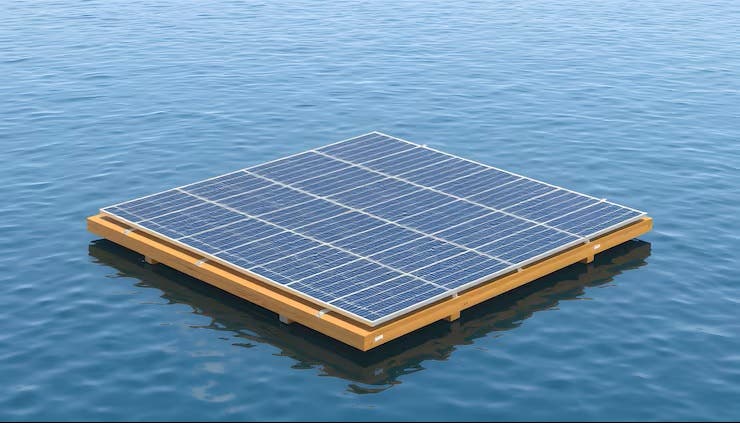Floating power: How scientists are turning raindrops into renewable energy
New floating droplet generator from Nanjing University turns rainfall into electricity using water itself as the electrode.

 Edited By: Joseph Shavit
Edited By: Joseph Shavit

Scientists have created a floating droplet electricity generator that turns rainfall into power using water as its own support and electrode. (CREDIT: Freepik)
Often associated with refreshing a sense of being renewed and a peaceful calmness, raindrops may soon become tiny engines of clean energy. Researchers at the Nanjing University of Aeronautics and Astronautics have created a floating electricity generator that captures energy from falling raindrops.
The device works without metal bases, rigid supports, or land. It’s part of a global race to develop sustainable energy solutions. Their work, published in the National Science Review, could transform how people think about energy from water.
A Novel Rain-Powered Technology
Droplet electricity generators (DEGs), which harness the energy from falling raindrops on a solid metal base to create electricity, are a traditional type of device. DEGs work effectively, but they are heavy, costly, and limited to land-based use, making them impractical for the Great Lakes, rivers, and oceans, where ground support is much less reliable.
The design of this device, along with the research by the Nanjing team, is known as a water-integrated floating droplet electricity generator, or W-DEG, which uses the water as the bottom electrode and the floating base. This new W-DEG weighs only a small percentage of a conventional generator design and costs just a little less than half as much to fabricate. And while it weighs a small fraction of a conventional generator, it can still produce a potent voltage of 250 volts every time a droplet makes contact with its surface.
Wei Deng, the lead researcher, calls it a “nature-integrated” design, meaning that it draws on the properties of water directly to achieve the same task as using heavy metals and synthetic materials.
Collecting Energy from Every Droplet
When a raindrop lands on the W-DEG’s surface, a thin film of fluorinated ethylene propylene (FEP) responds immediately. The droplet disperses, creating a stream of ions that cause charge transfer between the upper and lower regions. A tiny amount of electricity is generated, and when the droplet bounces, the surface resets to be ready for the next event.
Due to water being a high-surface-tension material and virtually impossible to compress, it can withstand the impacts without bending or breaking. Tests indicated that tap water, lake water, and even lightly salted water were just as good as pure water. The research team discovered that the electrical resistance of the sputtered natural water was low enough to allow for strong current flow and confirmed that the water itself could be trusted to function as an electrode.
Light, Cheap, and Strong
.Replacing metal and rigid materials with water resulted in a significant reduction in cost and weight. A traditional droplet generator costs about 210 yuan (about $29) per square meter and weighs over four kilograms. A floating version constituted about 106 yuan ($15) and weighed only 0.5 kilograms per square meter.
This is an 87 percent reduction in weight that makes transportation and deployment to large surfaces easy. It can float freely on a lake or even drift with waves and glean power from rain events. The FEP film, being chemically inert, resists corrosion, extreme temperature variation, and biological growth (e.g., algae, bacteria).
During field tests, the generator maintained functionality after a week in highly saline water. If the surface was splashed or debris landed on it, a simple cleaning would return it to maximum performance. To mitigate any build-up of contaminants, the team incorporated small self-draining holes in the droplets that allow water to drain downward but not up, using gravity and surface tension to maintain a clean surface.
From Laboratory Model to Scalable Arrays
The Nanjing team did not stop with a single device. They connected multiple devices into floating arrays to demonstrate how these technologies could scale. Each small generator produced distinct voltage pulses of approximately 200 volts per droplet and was able to produce enough voltage to power up 50 LEDs.
In a trial, 10 W-DEG devices were piloted into a 0.3 m2 (square meter) device about the size of a coffee table, creating a prototype. When simulated rainfall was produced from 120 mock rainfall droppers, the capacitor charged to three volts in minutes enough to power a wireless water quality sensor, for instance, or run other small electronics.
“By allowing water itself to play a structural and electrical role in the system, this work represents a considerable step forward. With W-DEGs, we have established a new strategy for droplet electricity-generation that is light-weight, cost-effective, and scalable,” said Professor Wanlin Guo, a corresponding author for this study.
Resilient by Design
The floating generator is not solely clever engineering—it was designed to withstand the elements, too, both in temperature and salinity (up to 500 millimolar of sodium chloride). Even biofouling, a considerable issue for any marine device, had little to no effect. Since most microorganisms consist primarily of water, they did not affect charge transfer.
The researchers believe that if protective barriers were added around the film edges (to protect when in high biofouling environments) that long-term durability could be improved, especially in rainy conditions.
Toward Land-Free Renewable Energy
The simple nature of the W-DEG technology provides the promise of a new type of renewable energy, landless renewable energy. As a floating device on a lake, river, or even the ocean surface, the W-DEG technology could produce kinetic energy from rainfall and/or waves within the same ecosystem.
The W-DEG design philosophy reflects a broader movement in science toward “nature-integrated” systems that strive to unleash nature’s materials for human-made technology. Instead of replacing nature, the W-DEG actually partners with it. For the first time, water is both the power medium and the structural material for the device itself.
Practical Implications of the Research
Any W-DEG design could be robust to power remote monitoring systems, as one example, of sensors that detect water quality or water pollution. Consistently rainy regions may be able to utilize it for backup energy in their remote devices, or in rural areas for microgrids without metal fuel or batteries, which has less environmental impact.
Developing countries could utilize this technology to affordably add another landless renewable energy source that could be deployed on lakes/reservoirs without large changes in the environment.
Globally, the ideas here could be factors in filling gaps in solar and wind energy, especially during cloudy or stormy conditions where other systems may fail. W-DEG’s design philosophy allows for nature’s materials to be used to generate clean energy.
These kind of ideas would be useful for future renewable energy research and eco-based technologies moving forward.
Research findings are available online in the journal National Science Review.
Related Stories
- Emission-free generator can power your home for days using half the water you need to flush the toilet
- New 'Super Steel' pulls green hydrogen directly out of seawater
- Breakthrough technology harnesses clean energy from falling rainwater
Like these kind of feel good stories? Get The Brighter Side of News' newsletter.
Rebecca Shavit
Science & Technology Journalist | Innovation Storyteller
Based in Los Angeles, Rebecca Shavit is a dedicated science and technology journalist who writes for The Brighter Side of News, an online publication committed to highlighting positive and transformative stories from around the world. With a passion for uncovering groundbreaking discoveries and innovations, she brings to light the scientific advancements shaping a better future. Her reporting spans a wide range of topics, from cutting-edge medical breakthroughs and artificial intelligence to green technology and space exploration. With a keen ability to translate complex concepts into engaging and accessible stories, she makes science and innovation relatable to a broad audience.



